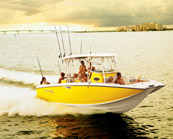Is your boat adequately protected from a strike?
By Capt. Vincent Daniello
I’m always taken aback when statistical long shots are described in terms of the chance of being struck by lightning. Sure, the odds of a person directly catching a bolt from the blue are quite low — about one in 700,000 in a calendar year, according to the National Weather Service. But put that same person aboard a boat and the likelihood changes — BoatU.S. insurance claim statistics show about 1.5 of every 1,000 powerboats are struck each year (as are roughly five sailboats). Is your boat protected if it should be one of those hit?
The short answer is: Probably not. Chances are, it would fare as well as my friend’s 60-foot sport-fishing boat that was struck by lightning at the dock hours before a planned fishing trip by what experts termed "a mild strike." All of the boat’s fixed electronics were rendered inoperative. The engines still ran, but they smoked and misfired horribly, with one unable to exceed 750 rpm. The shore power and both generators were knocked out, as were all the LED running lights. The bow thruster was activated and was stuck running hard to port. (The big DC solenoid literally melted and was making continuous contact.)
The lightning entered on its destructive journey through an outrigger. The charge found its way through the arm that holds the outrigger in its raised position and into the hardtop’s aluminum support rails. From there, the current flowed down the hardtop bonding wire, eventually exiting through the engine block, the transmission and the propeller shaft into the water. It also exited through the bow thruster and the shore power connection.
If it had such a clear path, a veritable freeway for its journey, how did it damage so much equipment along the way? "Lightning covers all frequencies, from DC to daylight," says James Coté, an electrical engineer and service manager at Ward’s Marine Electric in Fort Lauderdale, Florida. Coté explains that high-frequency electricity will transfer from one wire to another without a direct electrical connection — known as electromagnetic induction. "As current passes through one wire, it will induce a current into any wire close to it," he says. So on my friend’s boat, by routing the lightning voltage through the hardtop bonding cable that lay next to wires feeding power and data to the electronics, induction energized those wires, which in turn damaged the attached equipment.
Damage to the engines occurred more directly. Like most yachts, this boat was properly bonded — meaning all underwater metal fittings and large metal objects were tied together electrically. Such component bonding protects people aboard the boat, collecting and routing the lightning’s energy safely. The problem was the boat’s exit ramp, so to speak. Propellers, with their large surface area and sharp corners, dissipate electricity well, providing an efficient path to ground. But using them for this purpose energizes engines and transmissions along the way. On my friend’s boat, the electronic brains of the engines, housed within grounded metal boxes, actually survived, but the lightning that flowed through the engines wiped out sensors that monitor everything from turbo boost to injection timing. This resulted in the boat running horribly; but it still ran. (According to diesel mechanics familiar with lightning damage, this is typical, although in rare instances one or both engines won’t run at all.)
The lightning protection system installed on the boat in question is not uncommon and reflects production boat standards. The boat was built by a well-known company, and an equally reputable firm installed the tower and outriggers. But it could have been more effectively protected. Coté explains that if a heavy wire (out of close proximity to other wiring) had been run from the base of the outrigger — a likely potential target for a lightning strike — to proper lightning grounding strips in contact with the water, damage to the electronics may have been avoided, or at least reduced. This strategy could have spared the engines as well. If the tower and outriggers had not been bonded, the current would have used the electrical equipment’s wires to reach ground, causing even more devastation.
A well-maintained bonding system tied to at least one square foot of underwater metal typically protects people and prevents fire and structural damage. While some misinformed old-timers say this encourages a strike by providing a clear path to ground, the simple fact is a boat will always be a better conductor than air, so if it is near enough to a strike, it will become part of it. If we don’t provide an appropriate path to ground, the lightning will improvise, jumping from one conducting object to the next — called "side flashing." It will make its way through galley appliances, water tanks, engine blocks and possibly people until it reaches the water.
Ewen Thomson is a former electrical engineering professor at the University of Florida and a marine lightning expert. He examined one sport-fishing boat after its ungrounded outrigger was struck. "Once the voltage got inside the boat, it started flashing all around," Thomson says, explaining that once theses flashes were close enough to the water to overcome the resistance of the air, they jumped directly to the water and through anything in their way. "There were 40 large holes and hundreds of smaller ones through the hull," he says. Tying large metal objects together via the ship’s bonding system helps prevent side flashes. Thomson strongly recommends running main lightning conductors out near the hull sides, not down the boat’s center, and providing multiple exit terminals around the boat. "What we want is a series of conductors toward the outside of the boat that form a cage," he says. "People and equipment inside that cage are all at the same voltage, and therefore protected."
Thomson, a Ph.D. who has studied lightning since 1972, has also come to understand that lightning isn’t seeking a path underwater, but rather a path to the surface of the water. In simple terms, lightning is a buildup of static electricity, generally consisting of a positive charge on earth and a negative charge in the clouds. When the charge builds high enough to overcome five miles of the atmosphere’s resistance, lightning bolts neutralize these two charges. "But you can’t build up a charge inside a conductor," Thomson explains. "The charge flows through the conductor until it reaches the surface." This is an overriding principle in how Thomson designs lightning protection systems.
Directing lightning below the surface of the water before it exits the protection system, then back up to the water’s surface, actually raises voltage because the water, says Thomson, "causes an impediment to the current flow — impedance in electrical terminology. As impedance goes up, voltage goes up, and every conductor on the boat is at risk of forming side flashes." Thomson also points out that people are excellent conductors. For this reason he places through-hull electrodes — effectively reverse lightning rods — around the boat near the waterline to dissipate the strike.
Shared with Permission from MotorBoating.


